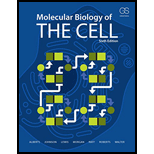
Concept explainers
A.
To explain: The model which accounts more readily for the features of the highly rearranged chromosomes.
Concept introduction: Chromosomal aberrations are changes in the normal structure of chromosome by addition, deletion, inversion and translocation. Chromosomal aberrations results in change in the gene order and inactivation of genes. If the genes involved in cell cycle are inactivated then cell cycle errors occurs which leads to cancer cells. There are two models regarding rearrangement of chromosomes which are studied that account for 2 to 3 % of all cancers which includes: Progressive Rearrangements Model (PRM) and Chromosome Catastrophe Model (CCM). Progressive Rearrangements model is where continuous chromosomal aberrations take place and several genes are rearranged. Chromosome Catastrophe Model is where the chromosome gets broken into several fragments and then stitched back together by Non Homologous End Joining (NHEJ).
B.
To explain: The way in which multiple chromosomal rearrangements arise.
Concept introduction: Chromosomal aberrations are changes in the normal structure of chromosome by addition, deletion, inversion and translocation. Chromosomal aberrations results in change in the gene order and inactivation of genes. If the genes involved in cell cycle are inactivated then cell cycle errors occurs which leads to cancer cells. There are two models regarding rearrangement of chromosomes which are studied that account for 2 to 3 % of all cancers which includes: Progressive Rearrangements Model (PRM) and Chromosome Catastrophe Model (CCM).
C.
To explain: The arrangements are likely causative agents of cancers in which they have found or the rearrangements are just passenger events that are unrelated to cancer.
Concept introduction: Chromosomal aberrations are changes in the normal structure of chromosome by addition, deletion, inversion and translocation. Chromosomal aberrations results in change in the gene order and inactivation of genes. If the genes involved in cell cycle are inactivated then cell cycle errors occurs which leads to cancer cells. There are two models regarding rearrangement of chromosomes which are studied that account for 2 to 3 % of all cancers which includes: Progressive Rearrangements Model (PRM) and Chromosome Catastrophe Model (CCM).
To explain: The way in which chromosome rearrangements activate an oncogene or inactivate tumor suppressor gene.
Concept introduction: Chromosomal aberrations are changes in the normal structure of chromosome by addition, deletion, inversion and translocation. Chromosomal aberrations results in change in the gene order and inactivation of genes. If the genes involved in cell cycle are inactivated then cell cycle errors occurs which leads to cancer cells. There are two models regarding rearrangement of chromosomes which are studied that account for 2 to 3 % of all cancers which includes: Progressive Rearrangements Model (PRM) and Chromosome Catastrophe Model (CCM).
Want to see the full answer?
Check out a sample textbook solution
Chapter 20 Solutions
Molecular Biology of the Cell (Sixth Edition)
- In one paragraph show how atoms and they're structure are related to the structure of dna and proteins. Talk about what atoms are. what they're made of, why chemical bonding is important to DNA?arrow_forwardWhat are the structure and properties of atoms and chemical bonds (especially how they relate to DNA and proteins).arrow_forwardThe Sentinel Cell: Nature’s Answer to Cancer?arrow_forward
- Molecular Biology Question You are working to characterize a novel protein in mice. Analysis shows that high levels of the primary transcript that codes for this protein are found in tissue from the brain, muscle, liver, and pancreas. However, an antibody that recognizes the C-terminal portion of the protein indicates that the protein is present in brain, muscle, and liver, but not in the pancreas. What is the most likely explanation for this result?arrow_forwardMolecular Biology Explain/discuss how “slow stop” and “quick/fast stop” mutants wereused to identify different protein involved in DNA replication in E. coli.arrow_forwardMolecular Biology Question A gene that codes for a protein was removed from a eukaryotic cell and inserted into a prokaryotic cell. Although the gene was successfully transcribed and translated, it produced a different protein than it produced in the eukaryotic cell. What is the most likely explanation?arrow_forward
- Molecular Biology LIST three characteristics of origins of replicationarrow_forwardMolecular Biology Question Please help. Thank you For E coli DNA polymerase III, give the structure and function of the b-clamp sub-complex. Describe how the structure of this sub-complex is important for it’s function.arrow_forwardMolecular Biology LIST three characteristics of DNA Polymerasesarrow_forward
 Human Anatomy & Physiology (11th Edition)BiologyISBN:9780134580999Author:Elaine N. Marieb, Katja N. HoehnPublisher:PEARSON
Human Anatomy & Physiology (11th Edition)BiologyISBN:9780134580999Author:Elaine N. Marieb, Katja N. HoehnPublisher:PEARSON Biology 2eBiologyISBN:9781947172517Author:Matthew Douglas, Jung Choi, Mary Ann ClarkPublisher:OpenStax
Biology 2eBiologyISBN:9781947172517Author:Matthew Douglas, Jung Choi, Mary Ann ClarkPublisher:OpenStax Anatomy & PhysiologyBiologyISBN:9781259398629Author:McKinley, Michael P., O'loughlin, Valerie Dean, Bidle, Theresa StouterPublisher:Mcgraw Hill Education,
Anatomy & PhysiologyBiologyISBN:9781259398629Author:McKinley, Michael P., O'loughlin, Valerie Dean, Bidle, Theresa StouterPublisher:Mcgraw Hill Education, Molecular Biology of the Cell (Sixth Edition)BiologyISBN:9780815344322Author:Bruce Alberts, Alexander D. Johnson, Julian Lewis, David Morgan, Martin Raff, Keith Roberts, Peter WalterPublisher:W. W. Norton & Company
Molecular Biology of the Cell (Sixth Edition)BiologyISBN:9780815344322Author:Bruce Alberts, Alexander D. Johnson, Julian Lewis, David Morgan, Martin Raff, Keith Roberts, Peter WalterPublisher:W. W. Norton & Company Laboratory Manual For Human Anatomy & PhysiologyBiologyISBN:9781260159363Author:Martin, Terry R., Prentice-craver, CynthiaPublisher:McGraw-Hill Publishing Co.
Laboratory Manual For Human Anatomy & PhysiologyBiologyISBN:9781260159363Author:Martin, Terry R., Prentice-craver, CynthiaPublisher:McGraw-Hill Publishing Co. Inquiry Into Life (16th Edition)BiologyISBN:9781260231700Author:Sylvia S. Mader, Michael WindelspechtPublisher:McGraw Hill Education
Inquiry Into Life (16th Edition)BiologyISBN:9781260231700Author:Sylvia S. Mader, Michael WindelspechtPublisher:McGraw Hill Education





